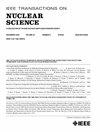Weak Conductive Channel Effect of Glass Fabric on Deep Charging of Polyimide in GEO
IF 1.9
3区 工程技术
Q3 ENGINEERING, ELECTRICAL & ELECTRONIC
引用次数: 0
Abstract
Spacecraft operating in the geosynchronous orbital (GEO) environment often experience deep dielectric charging effects in their internal insulation materials, while researchers have attempted to optimize the internal electric field through material modification and internal grounding techniques. Therefore, this article combined the advantages of material modification and structural optimization to establish a glass fabric-modified polyimide structure. We employed a Geant4-COMSOL joint simulation method to obtain the electric field strength distribution under the flux model for internal charging (FLUMIC) electron radiation environment for both single-layer glass fabric modifications at different positions and multilayer glass fabric modifications at varying layer counts. The results indicate that under a single-layer glass fabric-modified structure, the modified glass fabric at Position 3 exhibits the lowest maximum electric field strength. Additionally, according to the glass fabric position, the charge transport behavior in the single-layer glass fabric-modified structure was analyzed through three typical cases by a charge transport model. Finally, the engineering value of the multilayer glass fabric-modified structure was assessed from three dimensions: process design, maximum electric field strength, and electric field distortion rate. For multilayer glass fabric structures, as the number of layers increases, the maximum electric field strength is progressively suppressed, but the mass and manufacturing complexity also increase, imposing an additional burden on the spacecraft. The comprehensive analysis suggests that for practical engineering applications, a three-layer glass fabric modification at Positions 1, 3, and 5 should be adopted to suppress the occurrence of charging phenomena in 1.6-mm polyimide under the GEO environment.求助全文
约1分钟内获得全文
求助全文
来源期刊

IEEE Transactions on Nuclear Science
工程技术-工程:电子与电气
CiteScore
3.70
自引率
27.80%
发文量
314
审稿时长
6.2 months
期刊介绍:
The IEEE Transactions on Nuclear Science is a publication of the IEEE Nuclear and Plasma Sciences Society. It is viewed as the primary source of technical information in many of the areas it covers. As judged by JCR impact factor, TNS consistently ranks in the top five journals in the category of Nuclear Science & Technology. It has one of the higher immediacy indices, indicating that the information it publishes is viewed as timely, and has a relatively long citation half-life, indicating that the published information also is viewed as valuable for a number of years.
The IEEE Transactions on Nuclear Science is published bimonthly. Its scope includes all aspects of the theory and application of nuclear science and engineering. It focuses on instrumentation for the detection and measurement of ionizing radiation; particle accelerators and their controls; nuclear medicine and its application; effects of radiation on materials, components, and systems; reactor instrumentation and controls; and measurement of radiation in space.
 求助内容:
求助内容: 应助结果提醒方式:
应助结果提醒方式:


